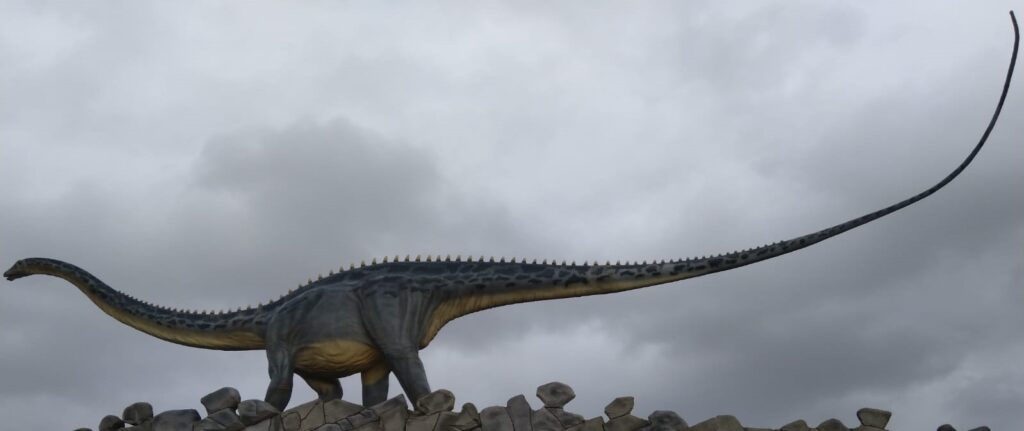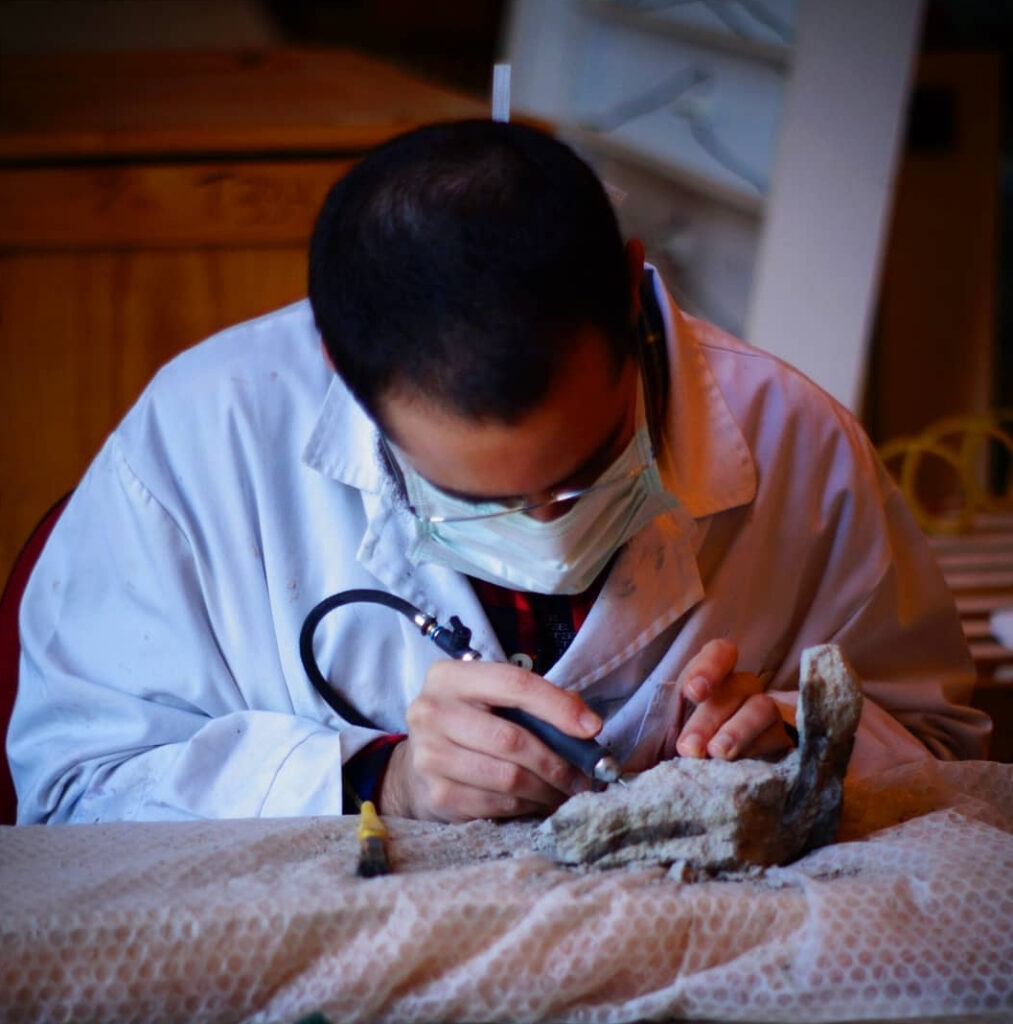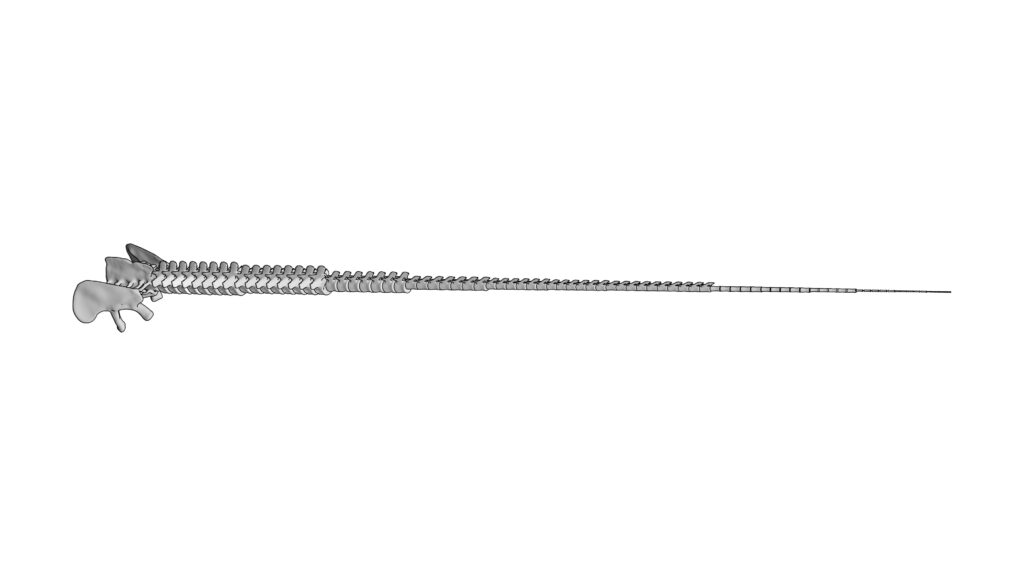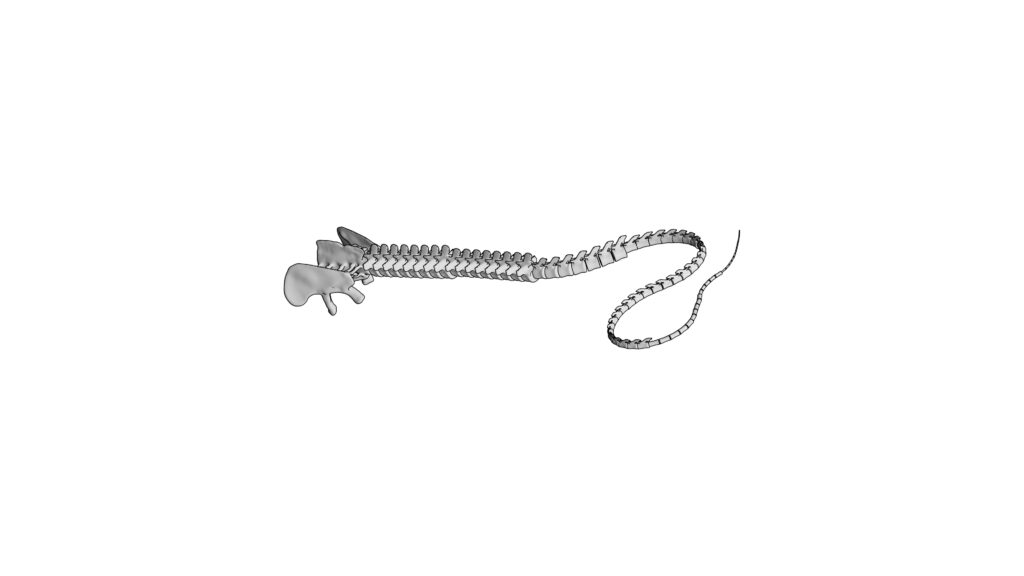We talked to Simone Conti, author of the study on dinosaur tails undertaken in collaboration between the Department of Aerospace Science and Technology at the Politecnico di Milano and the Department of Geology at the Universidade NOVA de Lisboa.
Simone is a palaeontologist, with a passion for dinosaurs, but also for aerospace engineering, which he has managed to weave into his studies and research.

How did your research on diplodocid tails come about?
Between the late 1800s and the early 1900s, some of the most complete dinosaur skeletons ever found so far were discovered in North America.
Since their discovery, there has been a wave of research which has made names such as Diplodocus, Apatosaurus or Brontosaurus well-known. These dinosaurs with long necks, whose tails were about 12-13 meters long, belong to the diplodocid family, herbivorous dinosaurs that lived in the Upper Jurassic. A peculiarity of these animals was that the caudal vertebrae went from tall and thick to little cylinders of just a few centimetres.
What is the scientific interest of this family of dinosaurs?
The function of a tail with such tiny end pieces was unclear; over almost 100 years, there were numerous hypotheses: among them, it was believed to have been used as a whip or as a third foot for standing upright on its hind legs.
A first computer simulation, dating back to 1994, was followed three years later by a more in-depth study; this study has become very famous because it demonstrated the tail’s capability to attain supersonic speeds. This means that diplodocids were the first living creatures to move faster than the speed of sound.
This image of the long-necked dinosaur able to break the sound barrier with its tail remained in the spotlight for 20 years, proven by a study in 2015 using a scale model constructed of aluminium and steel.

How did your carry out your study?
I wanted to learn to use the Multibody simulation method, which is commonly used by mechanical, aeronautical and aerospace engineers. This method simulates the behaviour of rigid bodies in space and the interaction that occurs between bodies connected at joints by applying certain forces. For example, this simulation is used in aerospace engineering to test the stability of the satellite when the solar panels are opened.
When I did the simulations on the model adopted years ago, I noticed that the simulation kept failing at supersonic speed, the maximum angle set between the vertebrae continued to be exceeded, meaning that in reality the tail would have snapped.
At this point, how did you act?
The only way to complete the simulation was to keep the model at much slower speeds. However, we are talking about models and, since any model is an approximation of reality, I needed to find evidence to support my argument.
I found the evidence in the soft tissues studies, i.e. everything that in biology is not bones, for example cartilage, muscles, tendons, etc. The study of the mechanical properties of these materials has shown that, even with the best mechanical properties, they would not have been able to withstand the stress of moving at supersonic speeds.

The study therefore detracts from the sensationalism a bit, because it impacts the collective imagination surrounding the mighty dinosaur…
Often, when we talk about dinosaurs, there is a tendency to “mythologise” these animals, when in reality they most probably behaved like currently existing animals, which does not remove any of the appeal of researching them, but if anything accentuates it.
Another myth about dinosaurs, which has been believed for a long time, is that sauropods, very large dinosaurs with a long neck, were aquatic. Until the early 1900s, it was indeed impossible to understand how these dinosaurs could walk; therefore, it was assumed for a long time that they needed hydrostatic force to stand, to the extent that one of the first dinosaurs found in England was named Cetiosaurus, which means ‘whale reptile’. It was only over time and with several studies that scientists came to understand that they were terrestrial animals.
Sometimes, even researchers and scientists become attached to certain ideas…
We need to be careful not to transform scientific research into a personal battle, even when we put all our efforts into it, but instead recognize that science progresses continuously.
In reality, even if they are contradictory, my article exists also thanks to the previous research, in particular the study in 1997. If it hadn’t been for this study, I would have had a much harder time reaching these results.
The beauty of science is precisely this: continuously reviewing, reworking and re-researching. Reviewing what has been done in the past using innovative approaches can lead to new results. This is why I believe that the winning formula is dialogue between different disciplinary fields, because it helps to find points of contact that did not exist until recently.
Your study is an example of this dialogue between different disciplines. What took you from palaeontology to a PhD in aerospace engineering?
I was one of those classic dinosaur-loving kids. Then, growing up, I got really into aerospace engineering, to the point that I passed the admission test for the Politecnico.
At that time, however, palaeontology was increasingly moving away from traditional methods, which consisted largely of just description, and becoming more open to new techniques and collaboration with other sciences, especially engineering and mathematics. It was the combination of engineering and palaeontology that re-ignited my passion for palaeontology; so I went on to study Natural Sciences at the University of Milan and Palaeobiology at the University of Bristol.
For my PhD, I wanted to study biomechanics; my desire and main motivation was to learn methods that belong to one specific area and then apply them elsewhere. It all started with Professor Giuseppe Sala, from the Department of Aerospace Science and Technology at the Politecnico, who later became my supervisor. With him, we initiated the collaboration with the Universidade NOVA de Lisboa in Portugal for a PhD scholarship funded by the Fundação para a Ciência e a Tecnologia.

Where do palaeontology and engineering meet?
In reality, the interplay between geology and engineering is very evident, especially with regard to building and structural engineering. Examples of the combination of palaeontology and engineering are now increasing, although they remain few. Among them is Emily Rayfield, professor at the University of Bristol, who carried out the first palaeontology studies using the finite element method (FEA); this method allows you to study objects with complicated geometry, such as bones for example, by breaking them down into lots of small, simple geometric elements.
The idea is therefore to study the skeleton of these giants of the past from an engineering sort of perspective, seeking to understand and dissect the secrets behind these animals. Dinosaurs are something we consider to be very old (just think of how we use the term ‘dinosaur’ to refer to old people in everyday speech);
Actually dinosaurs had a successful evolutionary history, given that they walked the Earth for 145 million years. Not to mention that dinosaurs are still among us: all birds are dinosaurs, from the chicken we eat for dinner to the pigeons in Piazza Duomo in Milan. Returning to the “real dinosaurs”, let’s take for example the Tyrannosaurus rex, one of the last dinosaurs, lived 65 million years ago; this means that there is much less time between us and the “T-rex” than between the “T-rex” and other dinosaurs. Getting an idea of these magnitudes helps us understand just how short a time we humans have been on Earth.
What are the benefits for you of this collaboration between disciplines, especially in the field of research and experimentation?
What I regard as fundamental, and which is proving successful in my work at the moment, is to look for new methods to be applied in areas in which they have not yet been applied. The methods I have used have already been optimised, but previously they were mostly used in areas other than palaeontology.
It certainly is not always easy; I experienced this difficulty myself when I realized that knowledge of soft tissues is an area still to be developed. The beauty of research in itself is precisely the freedom to seek, i.e. the ability to open the mind to investigate what is not yet known.
Actually, aerospace engineering is full of examples of solutions developed for space missions that have found common use in everyday life. As far as palaeontology is concerned, however, we often forget that the history of the Earth is much longer than the existing story. Take the climate, for example: given that there have been different climatic phases in the history of the Earth, studying climate change and the adaptation of animals to the changes provides us with models that are useful for predicting the future.

How can engineering methods and solutions be applied to the study of natural sciences?
In another study, that will be published soon, I talk precisely about how the natural world and engineering have often developed similar solutions independently of each other. Nature is a great testing ground for any engineering research.
There is for example a small insect, just a few millimetres long, that lives in meadows, commonly known as the spittlebug, which has the unique feature of being geared so that its back legs act simultaneously, which means it jumps in a perfectly straight line. The same solution of using gears is common, so much so that they are often present in Leonardo da Vinci’s drawings.
This next study is based on ostrich bones; in particular, the ostrich femur has a geodesic structure, that is, it has strengthening at 45 degrees to the long axis of the bone. Well, a very similar adaptation was used for the Vickers Wellington, a British WWII bomber, that adopted a geodesic structure for the wings and fuselage. These are just a few examples, but I believe there are many more that are not yet known.
Do your plans for the future involve this area of research?
Yes, one of my greatest desires is to continue with research, even if it’s not always easy. In particular, I would like to continue to develop this collaboration between engineering and natural science, also because it is a cutting-edge approach nowadays.
Take biomimicry, for example, which is an engineering approach that studies and imitates nature. Very interesting studies have recently come out on drones that use the rhythm and shape of birds’ wings to fly in a very controllable way Another recent study demonstrates how a drone, having the structure of bird legs, has the ability to cling and “perch” in the right place.
